Too quickly, our five-day, four-night Nile River cruise came to an end. We exchanged our boat for a van and continued south to Abu Simbel. A visit to Abu Simbel is an optional add-on for cruise passengers. I knew that we could save money and avoid crowds if we organized the 4-hour drive south of Aswan on our own. Our plan was to arrive at Abu Simbel after most of the cruise crowd had completed their visit so we could enjoy the temple on our own. Most of the cruise passengers depart for Abu Simbel early in the morning around 6 am, arrive at 10 am and finish their visit around 11 am/noon. We hired a van to depart Aswan two hours later around 8 am and arrive by noon. Mohammed, the owner of the guesthouse we stayed overnight at in Aswan, helped us to arrange the van and a local guide in Abu Simbel, which wasn’t very expensive at all.
When we first arrived, there were still quite a lot of people milling around, but mostly on the way out. Our guide told us that we had missed the big crowds. After half an hour, all of the crowds disappeared and we had the entire site practically to ourselves. It was magnificent!
After its first “discovery” during modern times in the early 1800s, Abu Simbel was discovered again by a mass audience in the 1960s when it faced potential disaster, during the planning of the Aswan High Dam. The new dam would have flooded Abu Simbel and submerged the site under water. Led by UNESCO, a multi-national team of archaeologists and engineers was assembled to dismantle both the Great Temple and the Small Temple, relocate and rebuild the two temples to a site 65 meters above their original location. It was an expensive endeavor that cost over USD 40 million. The entire two-year undertaking was documented by National Geographic, introducing the monument and its unique story to the world. Today, Abu Simbel is the second most visited attraction in all of Egypt, second only to the Pyramids of Giza.
Abu Simbel is made of two temples built by Rameses II between 1274 and 1244 BC to serve a few purposes – glorify himself, celebrate his victory over southern enemies and honor the gods. The larger temple that most people would probably recognize, is the Temple of Rameses II, also called the Great Temple. This temple is 30 meters high and 35 meters long.
The front face of the Great Temple features four colossal statues of Rameses II seated on his throne along with some smaller statues of royal family members and gods. Above the entrance of the temple is a statue of the falcon-headed sun-god Ra.
Just as we entered the temple, the kids got hold of a massive golden key (key of life). The temple caretaker encouraged the kids to play with and pose with the key. I already knew what was going to happen next. Tip! The caretaker was friendly enough so we went with the flow.
Inside the hypostyle hall, there are eight massive pillars of Rameses II depicted as Osiris, showing the never-ending, undying power of the pharaoh. On the walls of the hall are scenes of the pharaoh battling and defeating his enemies, mainly during the Battle of Kadesh or present-day Syria, where Rameses II defeated the Hittites. Other reliefs show battle scenes of Rameses II defeating the Libyans and Nubians.
Along the sides of the main hall, there are some small rooms which were lit just enough to illuminate the scenes on the wall reliefs. An eerie quietness blanketed the temple especially because by now, the temple was largely deserted and we were left alone to explore the rooms.
In the next hall, there are reliefs of Ramesses II and his favorite wife, Nefertari, making offerings to the gods. Through another doorway, there is a small sanctuary featuring four seated figures –Ra Horakhty, the deified pharaoh, Amun Ra and Ptah. By the time we reached the sanctuary, there were just a few people wandering inside the Great Temple and we could take all the time we wanted to examine the statues and take pictures. Twice a year (Feb 22 and Oct 22), the rays of the morning sun shine through the temple and illuminate the pharoah and Ra in his two forms (Ra Horakhty and Amun Ra). The light never shines on Ptah because he is associated with the underworld and lives in eternal darkness.
Besides the Great Temple dedicated to Rameses II, just a short distance away is the Small Temple that Rameses II commissioned in honor of his favorite wife, Queen Nefertari. This temple, standing 12 meters in height and 28 meters long, is noticeably smaller in comparison to the Great Temple. Its existence shows the important status of Queen Nefertari because it is one of the few times that a pharaoh dedicated a temple to his queen.
At the front of the temple stand colossi of Rameses II and Nefertari (4 of the pharoah and 2 of his queen). The size of the statues is significant because it is the first time that a queen was depicted equal in size to the pharaoh, a reflection of the love that Rameses II must have had for his favorite wife. Up to that point, the queen was typically depicted much smaller than the pharaoh in monuments and temples.
The goddess Hathor is featured prominently on the inside of the temple. She is the female counterpart to the main solar gods Horus and Ra. The walls inside the temple feature scenes of Rameses and Nefertari making offerings to the gods. For a while, we were the only visitors inside the Small Temple and we delighted in the chance to be alone with these ancient relics that have been marveled at ever since their original construction. Our visit was made even better now that I was well-equipped with my new book from the series “Alix’s Journey of Discovery” to guide us around
Traveling in a big family can be challenging because everybody’s level of patience and interest differ. Timing our visit to Abu Simbel to avoid the crowds allowed us to enjoy the experience without external pressure or interference. Instead of being jostled through the site, we could move at our own pace. When some of the kids lost interest, it was safe to split up. A few of us spent more time examining the temple while some of the kids sat and played outside, giving them a chance to relax and have a little fun. Because there weren’t many other people around, I didn’t have to worry about them disturbing others. Unlike some of the other more crowded temples that we visited, our time at Abu Simbel felt comfortable and relaxed, personal and immersive. I can’t think of a better atmosphere to learn in, in our classroom without walls.
Author
-

Song is the mother of four children. She and her family have stepped away from it all and in September 2023, began traveling the world while homeschooling. Song is an ABC (American born Chinese) and has an undergraduate degree from Cornell and an MBA from Harvard. She is an entrepreneur and an educator. Her hobbies include learning, traveling, reading, cooking and baking, and being with children.


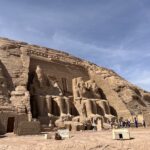



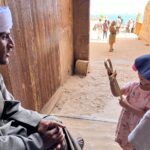
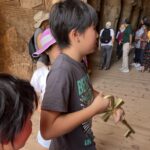
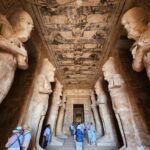
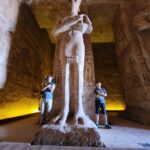
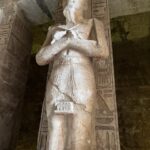
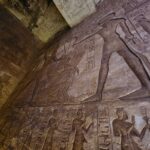
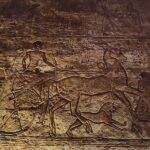


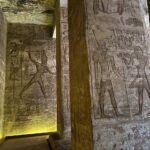

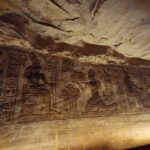

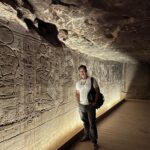
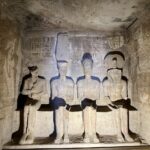
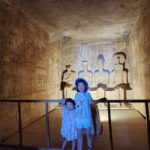


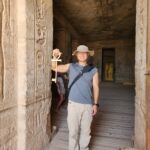
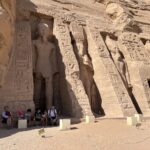
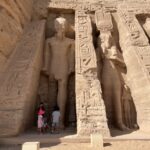
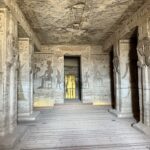





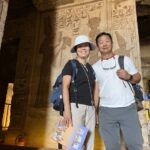
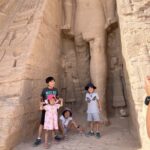
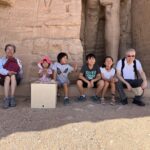



That was very smart how you planned to miss the crowds 😅😄
11/24 阿布辛貝神廟,哈索爾神廟
阿布辛貝神廟瞻,宏偉壯觀唯讚嘆。
二十世紀遷高地,大壩水位無憂患。
切割遷移組裝難,重建工作多挑戰。
感謝聯國教科文,歷史遺產保平安。
四尊巨像坐堂皇,不同時期法老王。
全是拉美西斯 II, 伐善施勞炫威望。
柱廊大廳石雕像,戰功偉績文圖樣。
精美壁刻天花板,日光按時照石像。
旁建神廟寵愛妻,妮菲塔莉併肩齊。
廟外六尊石立像,四尊法老二尊妻。
廟內通過柱廊廳,四周石壁刻畫精。
祭祀愛神哈索爾,寵妻建廟表愛情。
Amazing Chinese summary!